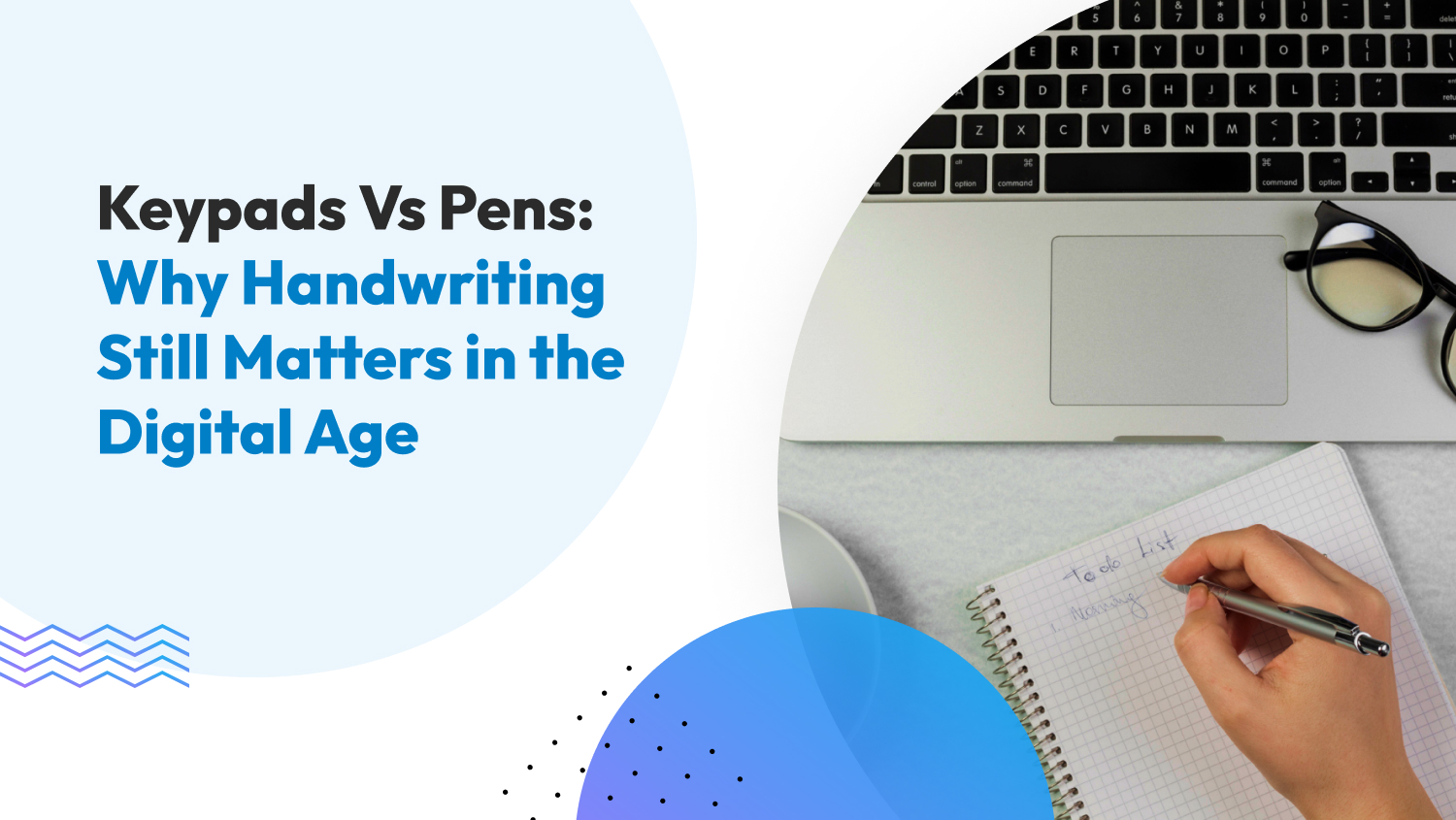Science Says
Keypads Vs Pens: Why Handwriting Still Matters in the Digital Age
From grocery lists on your notes app to contracts with clients in your Google Drive, digital documentation is the go-to for practically everything we need to remember. Speed, accessibility, ease of storage, and retrieval all make it seem superior in every way to old-school pen and paper record-keeping.
But what if we told you that slow and cumbersome writing with your hand has advantages when it comes to learning and remembering compared to typing? This recent study explored how writing with an ink pen, writing with a digital pen, and typing on a keyboard impacted learning of foreign language words. The results were promising for the digital pen and tablet.
The Multifaceted Nature of Learning
This study builds on research that began almost 20 years ago comparing how well preschoolers learned letters through writing by hand versus typing on a keyboard. A lot of studies have since looked at how children and adults remember and understand things – ranging from letters to full lectures – based on whether they used handwriting or punching keys on a computer. More recently, researchers have also been looking at how digital pens and tablets affect learning.
In this study, 33 participants, some who were regular users of digital pens (familiar group) and some who were regular ink pen users (unfamiliar with digital pens group), were tasked to study foreign words. Each group spent ten minutes ‘writing’ the foreign word by typing on a keyboard, writing with a digital pen, and writing with an ink pen.
They were then assessed based on: 1) how many times they were able to ‘write’ the foreign word within the ten-minute learning period, 2) their mood after the writing exercise, 3) accuracy in a post-test where they were asked to write the local language equivalent of all the foreign words learned, and 4) by a computerized ‘true/false’ test where they indicated if the foreign and local words being presented matched in meaning while their brain wave activity was tracked.
The researchers took a comprehensive approach to understanding learning by examining three key components: mood, behavioral or performance measures, and brain wave activity. This highlights that learning is far more than simply memorizing facts or passing tests. It’s a complex, multifaceted process that engages various aspects of our cognition, emotion, and even physical movements.
Action Item: When we assess our own learning or that of others, we shouldn’t rely solely on traditional metrics like test scores. For example, if you are studying a new tool, don’t just focus on memorizing steps or passing a certification test. Pay attention to how your attitude and mood change as you spend more time learning. Do you feel less dread and instead confidence whenever you log on to the software? Do you find yourself in a positive, energized mood? That can be an indicator of progress that puts you in a better position to master the new tool.
Or if you are ‘learning’ client outreach and networking, sometimes you just have to count how many reps you are able to put in, regardless of whether the potential clients convert.
Adopting a holistic view of the learning process gives us a fuller appreciation of the learning process that doesn’t happen instantaneously, but over a period of time (more on this later).

How Handwriting Stimulates the Brain
So how did the participants fare in the battery of assessments?
As expected, the study found that participants who typed were able to produce more repetitions of the target words during the learning phase. This might seem advantageous – after all, more practice should lead to better learning, right? However, the brain activity data tells a different story.
Researchers found that handwriting, whether with a traditional ink pen or a digital stylus, led to significantly higher brain activity during recall tests compared to typing. Researchers used EEG to measure the N400 event-related potential, a type of brain response that signals how easily and effectively we process the meaning of words. The higher the N400 ERP, the better the learning. The act of physically forming the letters seems to engage the brain in a way that facilitates deeper encoding.
Action Item: If your primary goal is speed or the ability to capture as much content as possible, typing is probably best. But consider handwriting for more complex or important information you want to understand and retain better. For important meetings or information you really need to remember, consider leaving the laptop at your desk and bringing a notebook and pen (paper or digital) to write key points by hand.
Digital Pens: Bridging the Gap
In this study, researchers wanted to pay particular attention to digital pens as an alternative to ink pens and keyboards. They looked separately at regular digital pen users and those unfamiliar with digital pens. In the regular digital pen users group, the N400 effect after digital pen use was significantly higher than after keyboard use. In the regular ink pen users group, the N400 effect after ink pen use was still higher than keyboard use. In short, brain wave activity for the tool they were familiar with outperformed keyboard use in both subgroups.
For participants who were regular users of digital pens, the brain activity benefits were comparable to those of traditional ink pens. This suggests that with practice, digital handwriting tools can potentially offer the same cognitive advantages as a simple ballpoint.
However, it’s worth noting that for those unfamiliar with digital pens, traditional pen and paper still held an advantage over both digital pens and typing. This underscores the importance of familiarity and comfort with our learning tools.
Action Item: If you’re interested in exploring digital note-taking, consider investing in a tablet and stylus. With practice, you may be able to combine the cognitive benefits of handwriting with the convenience of digital storage and organization.

The Mood Factor: Emotions and Learning
You might be wondering about the relevance of mood to the language learning experiment. Previous brain studies (here are a few: Hinojosa et al., 2017, Chwilla et al., 2011, Vissers et al., 2010) have shown that being in a good mood can help people understand and use language more easily.
Researchers found that using the ink pen made participants feel significantly more energetic and in a positive mood compared to typing, regardless of whether they were in the group who were unfamiliar with digital pens or those familiar.
Action Item: The impact of emotions and moods on learning and retention is a complex topic. For example, a certain level of stress and frustration can be conducive to learning, but if it is for an extended duration then it becomes detrimental.
Pay attention to your emotional state when learning or working. Choose tools and environments that help you focus and feel motivated. If that means using a notebook and ballpoint pen then, incorporate it into your learning or work routine.
The Long Game: Early Learning and Future Performance
We’ve talked about the experiment results on the number of repetitions participants were able to ‘write’ words using different tools (typing wins). We’ve also touched on the higher brain activity during recall tests for those who wrote by hand (digital and traditional ink outperform typing). And only one mode of writing (by ink pen) was associated with significantly better mood in participants than typing.
But which method of writing was associated with better performance on the recall tests conducted after the 10-minute learning session? The experiment results actually showed no significant difference in how well participants did on the recall tests across the different writing methods used for learning.
So what good are higher brain activity and a positive mood while learning when they don’t translate to better performance on retention tests? Researchers believe higher brain EEG readings during handwriting represent the early stages of effective learning while the impact on performance or behavior is manifested over a longer period of time.
They refer to several other experiments on language where both the learning period and the testing were extended to several weeks. One study found changes in brain activity after just 14 hours of language learning, but it took longer to see changes in test performance.
Another study had adults learn new characters by handwriting or typing for three weeks. Right after training, there was no difference in how well they recognized the characters. But three weeks later, people remembered the handwritten characters better than the typed ones.
A study with preschool children had similar results. Kids learned letters by handwriting with pencil, handwriting on a tablet, or typing. Right after training, there was no difference in how well they recognized letters. But four to five weeks later, kids who used pencils did better than those who typed.
The researchers acknowledge this as a limitation of their study, noting that they did not examine effects beyond the immediate 10-minute learning period and subsequent testing. This highlights an important aspect of learning that is often overlooked: sometimes, the most effective learning strategies don’t show immediate results. Just as physical exercise might not lead to visible changes right away but produces significant benefits over time, the cognitive “exercise” of handwriting might lead to stronger, more durable learning in the long run.
Action Item: Don’t be discouraged if you don’t see immediate improvements when adopting handwriting as a learning strategy. Consider maintaining a consistent handwriting habit, perhaps keeping a journal or taking handwritten notes regularly, and observe whether you notice improvements in your learning and memory over a few weeks.

Limitations
The study has several important limitations to consider. First, the sample size was relatively small (33 participants total, with only 12 in the “familiar with digital pens” group), which limits the generalizability of the findings. Another limitation is that the study focused solely on word learning, which is just one aspect of language acquisition and general learning.
As discussed in the previous section, the study only examined immediate effects after a brief 10-minute learning period, without examining or measuring longer term results. The theory that EEG differences are a leading indicator of longer term learning and retention needs further investigation.
Lastly, the study did not control for potential confounding factors such as individual differences in learning styles, extent of prior experience with the writing methods, or personal preferences for handwriting versus typing.
Wrap Up
It’s tempting to embrace new technologies wholeheartedly and leave older methods behind. However, this study reminds us that sometimes, traditional approaches have benefits that are only now being understood by modern neuroscience.
Typing and digital note-taking have their place, offering speed and convenience that can be invaluable in many situations. But for deep learning, complex problem-solving, or when we really need to engage with and remember information, handwriting – whether with ink or stylus – might be the better choice.
By understanding the multifaceted nature of learning and the unique benefits of different approaches, we can make more informed choices about how we learn, work, and process information. In doing so, we can harness the best of both traditional and modern methods to enhance our cognitive abilities and learning outcomes.












